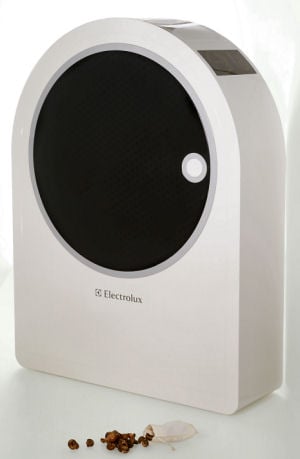These are few of the winners of 2007 competition held by the Electrolux Design Lab. Just like with high fashion shows, the outfits and models look fantastic, but hardly practical and wearable for everyday use. But in a future, who knows …

The solar-powered pot, Pebble is designed for precise, energy-efficient cooking. This pot will be using cutting-edge solar technology and induction heat for almost instantaneous heat transfer, aiming to combine sustainability with modern, urban lifestyles. The idea is to use photovoltaic energy together with spray-on solar cells, a cutting edge technology now under development in University of Toronto and hopefully to be available within seven years. The cells are also sensitive to both visible and non-visible radiation, which means they can produce energy even on a cloudy day. This technology allows any surface to be converted into a solar cell. The base of the Pebble contains an induction heating device. Induction technology heats up food by creating an electromagnetic field between the coil and the metal container. As soon as the container is removed, the heating stops, allowing a high degree of precision in cooking. Sounds good but is that feasible?

Pure Washer combines sink and dishwasher, and thus presents much more practical idea. It is a rotating appliance that is half-sink, half dishwasher and environmentally friendly because it will reduce water consumption and limit energy use. It also saves space. Pure Washer is divided into two parts. Each is a mirror image of the other, so when the consumer puts the dishes into the exposed half of sink, it rotates away under the counter to wash them. There is no need to wait until the appliance is full and, since the dishes are put in while still fresh, it only takes a couple of minutes to clean them. The appliance optimizes the amount of water and energy used, based on the space occupied in the chamber. There is also a cycle for washing fruits and vegetables. Sounds so simple it is quite brilliant. Feels like they stole my idea … ya, right.

Soap-nut washing machine, e-Wash is designed to wash without detergent, but with the soap nut, known also as sapindus mucorossi, which was used for laundry in India and Nepal for centuries. The soap nut is a natural plant and can be cultivated, plus it does not harm the nature but is a part of it. A kilogram of soap nuts would last the typical person a year, and soap nuts are good for people with allergies and gentle on clothes. The washer is also quite flat, so again, it will save some space. Can’t argue here …

Each honeycomb of this fridge of the future stores different food at its optimal temperature. That is right, the Go Fresh fridge will store different foods at different temperatures to ensure the longest lifespan for each food item. Another bonus is that odors of different foods can’t combine in honeycomb fridge unlike in conventional fridges. The refrigerator is composed of a main frame that produces cold air for 12 individual, temperature-controlled cells much like the cells of a honeycomb. When the cell reaches the correct temperature, the cold air inlet closes automatically, saving energy. The type of food in each cell is identified by scanning a picture of it and the appropriate temperature is set automatically. The cells themselves are insulated and can be removed, making it possible to take them on a picnic. Hmm, may be in 22nd century, but quite enticing.
See Electrolux 2006 Design Lab winners, KaionWAVE washing system, and Sunshine washer.